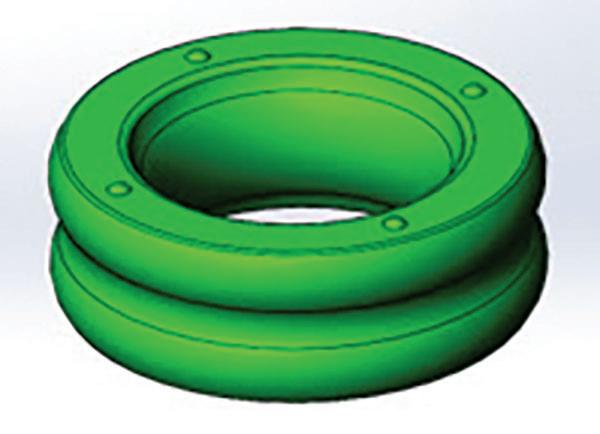
3 minute read
EXPERIENCE.
If you’ve got questions, we’ve got you covered.
• Wet or dry environments.
Failure to consider the critical requirements and functions may result in failures. Trelleborg
Sealing Solutions has an extensive compound portfolio, and it commonly formulates new materials to meet application-specific requirements for custom-tailored components.
Design features that influence product development
Molded rubber components vary in design complexity and can range from simple ring seals to complex subcomponents that must be overmolded together. The design will naturally push engineers toward di erent materials or processes. Here are some of the most common design features that will have an impact on your choice: bonding to occur, special adhesives must be applied to the insert before molding. This bond will keep an overmolded component as one object without relying on the component or insert shape.
Corners. Sharp corners are generally di cult to manufacture and increase the likelihood of component defects. Although costly, high-quality tooling can mitigate potential defects and impact the success of the end-product.
Undercuts. An undercut is a feature that projects back into the main body of a component. The closer an undercut comes to the axial center, the deeper the undercut. Deep undercuts provide their own set of challenges, as they make the component di cult to remove from the mold. Orientation also contributes to removal di culties. For example, if a deep cut is perpendicular to the mold opening, it can be impossible to remove the component from the mold.
Sharp edges. Components with thin edges, often referred to as “knife edges” or “feather edges,” usually tear as they are removed from the mold. Post-cure deflashing steps can further chip the edge, creating additional imperfections. If possible, it’s best to avoid incorporating knife edges in designs unless absolutely necessary. If your component does require a thin edge, squaring o the edge with a flat minimum of 0.010-in. will significantly reduce the likelihood of damage.
Incorporating inserts into component designs usually requires secondary preand post-mold tasks, such as insert surface etching, masking, unmasking, applying adhesive, and deflashing.
Flash. The excess rubber that escapes in small amounts from the mold while undergoing heating and pressure is called flash. Usually, this small amount of rubber is forced through the parting lines, or seams, between the tooling plates. It is common to remove flash as part of the post-molding process via manual tear trimming, cryogenic processing, tumbling, or precision grinding.
Overmolding. Sometimes elastomer components must be paired with subcomponents of other materials like steel, brass, aluminum, or plastic. Typically, the rubber compound is overmolded over the non-rubber subcomponent. When designing rubber overmolded components, there are a few design principles to keep in mind to maximize the strength of the bond between the elastomer and insert.
Gates. Transfer and injection molded components usually employ gates to ensure the compound uniformly flows into the tool. You can place gates at various locations on the cavity. Gate marks, the small, raised spots or depressions where the gate interacts with the cavity, are left behind after the molding process is complete and can sometimes impact seal functionality and appearance.
Holes. If your rubber component requires holes, a pin must be placed inside the mold cavity. This core pin is responsible for forming the internal contours of the finished component. The molding process uses high pressures with the potential to deflect the core pin and produce a hole with inconsistent dimensions. Designing core pins with diameters as large as possible, particularly at the pin base, will minimize the risk that the pin will bend or break during the molding procedure. Other guidelines to keep in mind:
• The hole height should not be more than twice the diameter.
• The minimum hole diameter should be 0.050-in.
• Cover as much of the insert’s surface as possible with rubber, maintaining a minimum thickness of 0.020-in.

• Avoid shutting o the flow while the compound travels along a vertical surface.
• Provide proper lands (steps).
Building the prototype
There are two types of bonding methods used when overmolding rubber to a subcomponent material:
• Mechanical bonds require the insert to feature holes, projections, or depressions on its surface. For chemical
When operations are running at maximum capacity, unforeseen issues can impact uptime significantly, leading to missed deadlines. Prototyping provides opportunities to refine designs and manufacturing processes before production and is essential to ensure full-scale production goes o without a hitch. During the prototyping phase, especially with complicated designs, it’s best to manufacture and test under conditions as close to the operational manufacturing environment as possible. DW
In 1980, Great Britain’s National Trust recommissioned Gondola, an 1859 steam-powered vessel for 86 passengers styled after a Venetian gondola, on Coniston Water in Cumbria, England.










